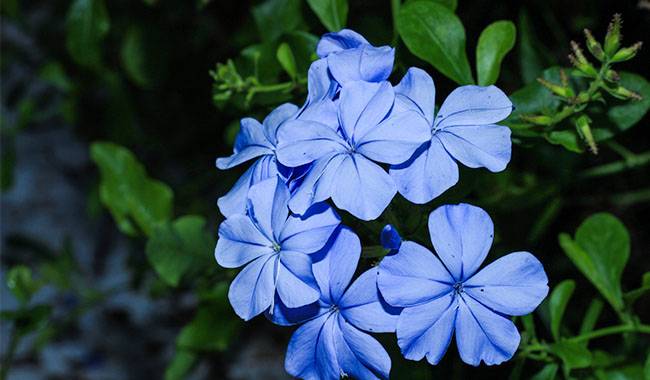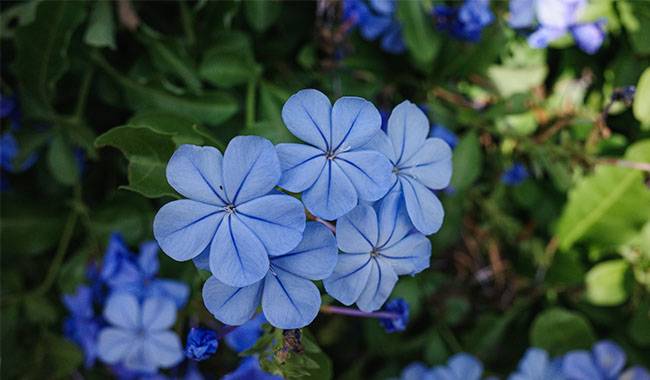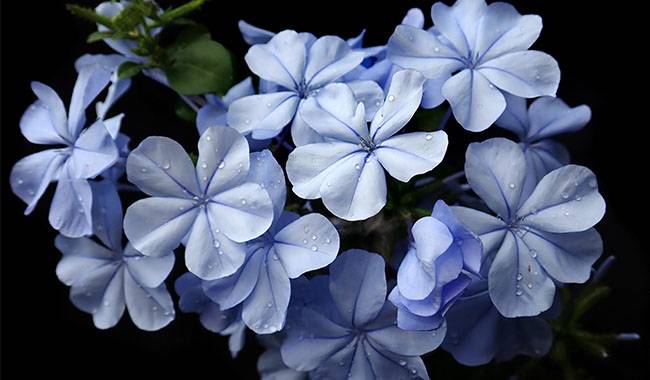
Plumbago Blue Flower is increasingly daring to be grown as a houseplant. The curly, gorgeous, and spreading hybrid has always been considered a special plant with its distinctive bright green color and charmingly simple flowers. First and foremost, it’s ornamental and blooms time. But this is not because of its special growth pattern and its demanding care and conditions. Lush flowers are impossible to achieve without observing strict rules of cultivation. This is almost always due to improper care during the resting phase and lack of light and air. In this article, ThumbGarden will learn how to grow and Plumbago cares Blue Flower.
PLUMBAGO PLANT DESCRIPTION
Plumbago (Leadworts flower) is a beautiful flowering, climbing evergreen shrub with flexible shoots up to 80 inches (2 meters) long that can be pruned into a shrubby form. Without it, it spreads out in all directions, forming evocative cascades and clouds. It has small, alternate, elliptic-lanceolate leaves up to 2 inches (5 cm) long, with an unusual, rippled, paper-like texture. The partially pubescent leaves appear as dazzlingly bright turf on the abaxial side.
Plumbago buds, with inflorescence branches protruding from the ends of the buds, are surprising. The five-petaled corolla is perfectly symmetrical. The simple, long tubular flowers, up to 1 inch (2.5 cm) in diameter, have a delicate fragrance and are particularly sensational due to their sparse hue and numerous inflorescence bunches. After some inflorescences, new inflorescences begin to grow, creating a lacy or foamy effect.
Modern cultivars and hybrids offer a choice of white, blue, and pink. For indoor cultivation, it is best to choose special compact varieties well suited for growing indoors or shrubby plants that are initially very young and better adapted.
Bright Moonflower blooms from spring to fall and is considered one of the most colorful Plumbago plants. Indoor Plumbago plants can bloom in waves for more than six months. But even the usual summer bloom is not easily achieved. The reasons why hybrids do not bloom or bloom less in a room are generally similar to any houseplant, but not quite.
Even in a room, the hybrid is still almost a garden plant, very fond of light, needing exposure to fresh air and proper compensation for all the negative factors. So let’s try to find out why Plumbago flowering problems appear and how to deal with them.
Incorrect soil and potting
Plumbago should be given room to grow actively by choosing large but deep enough pots proportional to the root system and increasing their size by 2 inches (5 cm) when transplanting. The presence of drainage holes is critical as it has a high drainage layer at the bottom of the container.
Plumbago plants bloom well only in weakly acidic peat substrates but should not be planted in pure peat. Peat mixed with nutrients from turf soil and sand with additional perlite or sphagnum soil is ideal. If it is a commercially available substrate, choose soil for flowering plants, particularly for Plumbago or fruit plants.
Frequent Plumbago transplants
Plumbago plants like to germinate and grow freely. Frequent transplanting is not good for it. Repotting is only necessary when the roots emerge in the drainage holes, not every year, but very early – before growth resumes in early spring. In years when transplanting is not necessary, it is best to replace the top 2 inches (5 cm) of soil with a nutritious soil mix in time.
It is important not only to avoid unnecessary transplanting but to do so carefully. Careful transplanting without disturbing the root ball will allow the Plumbago to grow and flower quickly with little to no noticeable change in the container. However, obliterating the soil can make the shrub so fragile that flowering may start late in the year or never.

Indoor temperature
Plumbago plants can easily cope with outdoor temperatures above 73 °F (23°C). Indoors, any excess is best offset immediately by proportional increases in ventilation and humidity. But, of course, high temperatures are not critical in the summer, but the winter.
Non-flowering is not always the fault of warm winters, but rather because sufficient measures have not been taken to adjust to the prevailing conditions. To achieve flowering in warm winter conditions, you have to work hard. Cool winters of 50-59 °F (10-15°C), with the possibility of dropping to 44 °F (7°C), are ideal for retaining foliage, compact and lush flowers. Above this temperature, it is necessary to maximize light, adjust watering, stop fertilizing, and prune appropriately in spring.
No pruning
This plant blooms only when young, the shoots themselves are hardly branched but are willing to stretch and bare themselves, producing leaves and flowers at the top. And, even if it is a formed shrub, it will still spread out and disperse, requiring considerable space. Therefore, good flowering cannot be achieved without annual pruning in late February or early March. Sometimes the plants are pruned in autumn to make them compact, but this will weaken Plumbago. It is worth first sterilizing, removing unhelpful, damaged shoots, and then stimulating the growth of new branches.
There is no need to worry about heavy pruning. Shoots can be shortened to a 6-12 inch (15-30 cm) “stump,” and the standard is to leave about a third of the length and at least 2-3 internodes. If the Plumbago is compact, or if you want to retain its natural shape, trim and shorten the tips. On young, unformed shrubs, it is best to create a base of 3 or 4 skeletal buds straight away. Then, as the Plumbago grows, it is best to secure it to support (arch, circle, ladder) by gently bending and twisting the shoots. Plumbago usually responds very strongly to twisting. If desired, you can form a thorny and strictly rounded outline.
If Plumbago becomes diseased, non-flowering, or elongated, stimulating pruning treatments can be applied throughout the season to shorten the shoots to “trigger” new growth.
Excessively dry substrates
The main task of regular maintenance of Plumbago is to prevent the soil from drying out completely. Plants with a dry substrate will not only fail to flower, but they will also lose their leaves and require urgent pruning. Ideally, make sure the substrate dries out, and water every time the top layer of soil becomes dry. Water frequently in summer and sparingly in winter, but do not overwater even bare-root shrubs. Overwatering is dangerous, as is waterlogging.
Incorrect watering
During active growth, you should carefully monitor the water temperature and let it warm up to the same temperature as the air, or even better, using 35-41 °F (2-5°C) warmer water. Sometimes it is cold water that causes non-flowering.
Equally dangerous is salinization of the soil, using hard well water instead of regular tap water. Plumbago is very sensitive to soil reactions and should not be watered “by any means necessary.”
Lack of light
The hybrid will not settle for one spot on any windowsill. It needs as much light as possible during the year. Not only will the hybrid be stretched and lose its foliage, but it rarely blooms.
It is only necessary to place it in direct sunlight at midday and only in summer. Partially, south-facing windows with screens, at least those facing west, are still ideal for this plant.
Whether to re-lamp Plumbago in winter is a moot point. The ideal is to overwinter in as bright a light as possible. However, since the plant needs to be pruned in the spring anyway, it can regenerate even if the shrub is pulled out. If it is only cool in a shady place, losing green is better than overwintering in a warm place.

Too dry or uncirculated air
If you don’t take indoor Plumbago out for fresh air when the temperature exceeds 71 °F (22°C), especially in summer, you will have to recreate almost greenhouse-like conditions. The optimum indoor humidity in hot weather is about 80%. You can put moist expanded clay, pebbles, or moss in a tray or arrange Plumbago and tropical plants around a humidifier.
This plant originally liked to spend the summer outdoors, flowering on balconies and patios. Even in winter, even a very careful lack of air will not affect the health of these plants. And during periods of intensive growth and flowering, they are even more important. Exposure to fresh air can compensate for leaving them in high temperatures and direct sunlight, as well as for their sub-optimal overwintering conditions. Therefore, if Plumbago problems, it is worth checking whether your shrubs are getting enough “breath.”
When positioning plants, it is worth noting that air should circulate freely around the canopy – on all sides.
Inadequate fertilization
Plumbago has a high demand for nutrients. If it lacks nutrients, it will not bloom. This is especially dangerous if the plant has not been replanted in the same year.
Fertilization should begin when growth resumes and continue until it stops completely, using a standard dose of fertilizer for beautiful flowering plants every 2 weeks (a general-purpose fertilizer can be used in early spring), in liquid form, in combination with watering. When choosing a fertilizer, make sure it contains trace elements, especially manganese, to which Plumbago plants are susceptible to deficiencies.
Sudden changes
Plumbago is not a plant that tolerates stress. Not only does it dislike temperature jumps, cold drafts, movement, sudden changes, but it also dislikes any contrast. It is best to slowly reduce watering while feeding – introduce and gradually stop in spring. If possible, gradually lower and raise the temperature so that the bush gets used to the spring sun.
All sudden changes will inevitably affect flowering. They can be postponed or canceled if the stress is too great.







